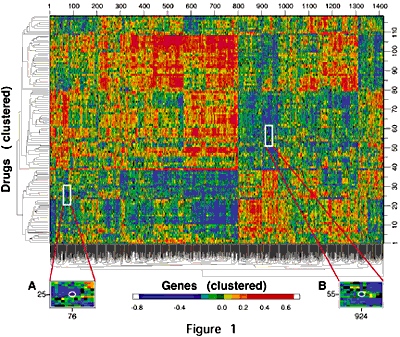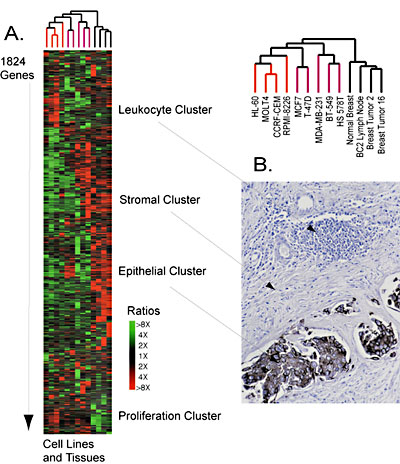Gene Expression (Microarray)
Глобальная Экспрессия Генов
|
The Rise of Free, Global Gene Expression Data Sets Researchers team up drug screening and microarray technology to deliver gene function information Jim Kling The Scientist 16[7]:34, Apr. 1,2002 |
For this article, Jim Kling interviewed Patrick O. Brown, Howard Hughes Medical Institute investigator and professor in the department of biochemistry, Stanford University Medical School in Stanford, Calif., и John N. Weinstein, senior investigator at the National Cancer Institute and head of the genomics and bioinformatics group, in Bethesda.
|
|
В 1990 National Cancer Institute (NCI) начал скрининговый проект тестирования 70,000 соединений против 60 опухолевых клеточных линий человека различного происхождения, включая colon, breast, prostate, kidney, brain, ovary, leukemias и меланомы. Помимо идентификации многочисленных лекарств это привело к получению важных экспериментальных результатов.
Patrick O. Brown, который был пионером новой технологии микромассивов (microarray)использовал ее для получения "снимков" профиля экспрессии генов жрожжевых клеток. Со временем он начал работать с некоторыми клеточными линиями человека.
Два человека (Brown, Weinstein) решили сотрудничать: Weinstein's команда сфокусировала свое внимание на профилях генной экспрессии в клеточных линиях в ответ на различные соединения, а Brown с сотрудниками сконцентрировались на базовой клеточной биологии. Weinstein's группа выполнила большую часть работы по клеточной биологии, тогда как Brown and company проводили гибридизацию и сканирование массивов(arrays). В марте 2000, результатом этого сотрудничества стали две работы в
Nature Genetics.
Это "one of the first examples of using this systematic
approach to look at gene expression in a large, self-consistent set of
examples as a way of getting insights into the functions of genes on a
large scale," заявил Brown. "Also, the fact that it was one of the first
large, freely available global gene expression data sets means it was used
as raw material for a lot of computational biologists developing
algorithms for analysis of global gene expression."
| ©2000 Nature Genetics |

Our Cells on Drugs: A Clustered-Image Map,
relating the activity patterns of 118 tested compounds, to the
expression patterns of 1,37 genes in the 60 cell lines. (Nature
Genetics, 24:236-44, 2000.)
|
Getting the System Down
После поиска в базе данных генов для известных генов человека и удаления различных генов домашнего хозяйства ("housekeeping"), которые экспрессировались на одинаковых уровнях во всех линиях клеток, в осадке осталось 9,703 фрагментов кДНК, представляющих примерно 8,000 генов. Из фрагментов кДНК сформирован микромассив.
| ©2000 Nature Genetics |

Express Yourselves: A side-by-side look at gene
expression patterns in clinical breast cancer specimens and cultured
breast cancer and leukemic cell lines. (Nature Genetics,
24:227-35, 2000.)
|
Некоторые из этих 8,000 были уже исзвестными генами человека, тогда как др. гены были гомологами генов, найденных у др. организмов; остальные были expressed sequence tags (ESTs). Brown's группа затем гибридизировала флюоресцентно меченные кДНК из этих выборок. Производили сравнение сигналов из каждой выборки для идентификации вариаций в экспрессии генов. "One of the characteristics of this kind of data that distinguishes it from other data looking at gene expression is that it is quantitative and systematic, and that allows the data to be analyzed in a lot of systematic ways," отметил Brown.
Kevin Coombes, an associate professor and head of the bioinformatics section at the MD Anderson Cancer Center in Houston, Texas, который выиграл в 2001 соревнование Critical Assessment of Microarray Data Analysis (CAMDA), отмечает: "[CAMDA] has a very nice structure to it. You take one or two data sets and get a whole bunch of people to apply their methods to the same sets". Приятная новость, что "most of these methods tend to find the same things."
Doing It Cheaply
Brown намеревался осуществить исследования микромассивов, которые "were cheap [so] we could do tons of these experiments and it would be no big deal. The most critical thing about this paper is it was part of a strategy of building a map of the gene expression program that would be an interpretive framework, so that each [future] experiment of this kind would be a lot more meaningful than if it were done in isolation." Для достижения этой цели Brown отпечатал очищенные кДНК на glass microarray, используя робот с четырмя печатающими tips...
1. J.E. Staunton et al., "Chemosensitivity prediction by
transcriptional profiling," Proceedings of the National Academy of
Sciences, 98:10787-92, Sept. 11, 2001.

Сайт создан в системе
uCoz 
